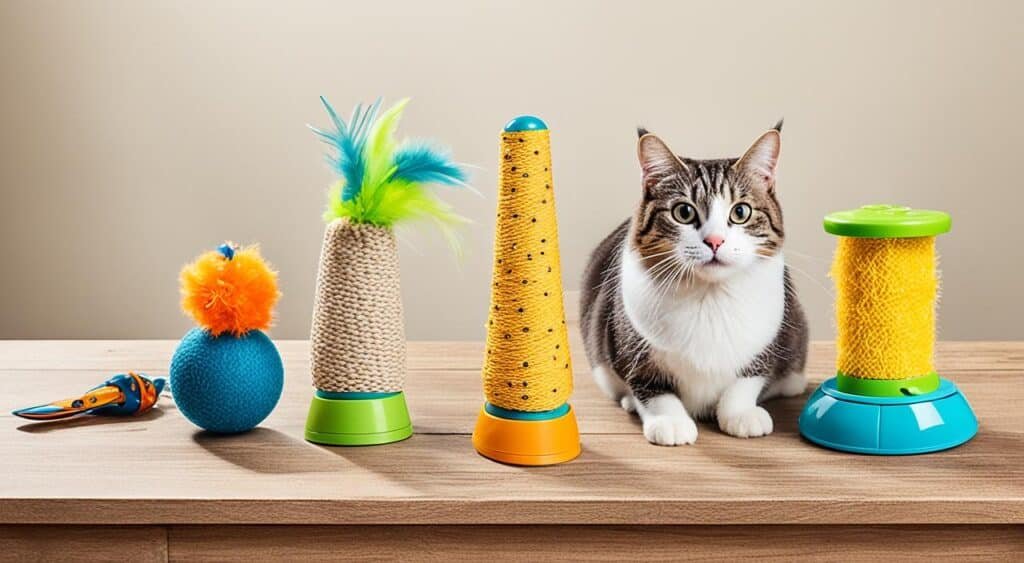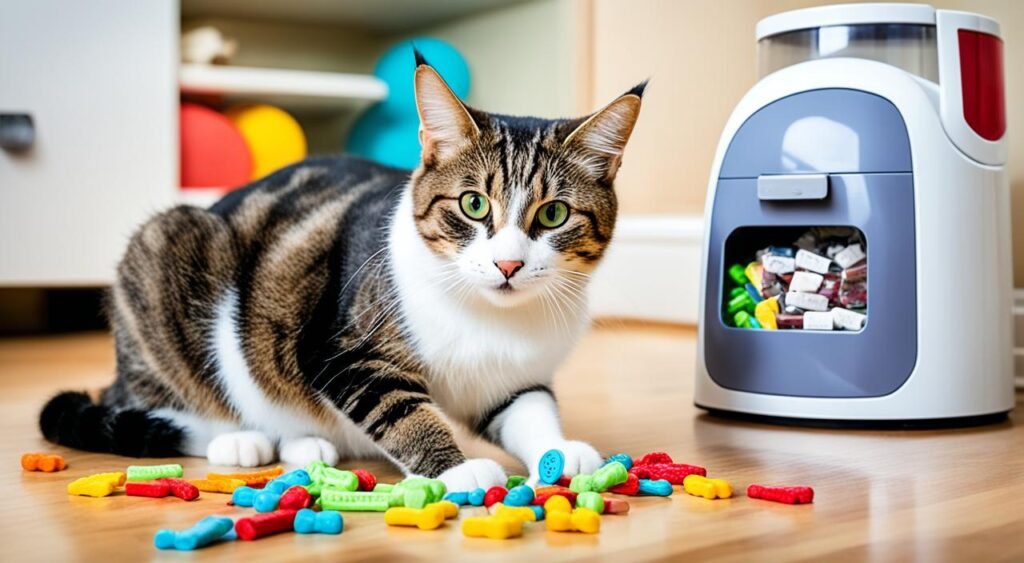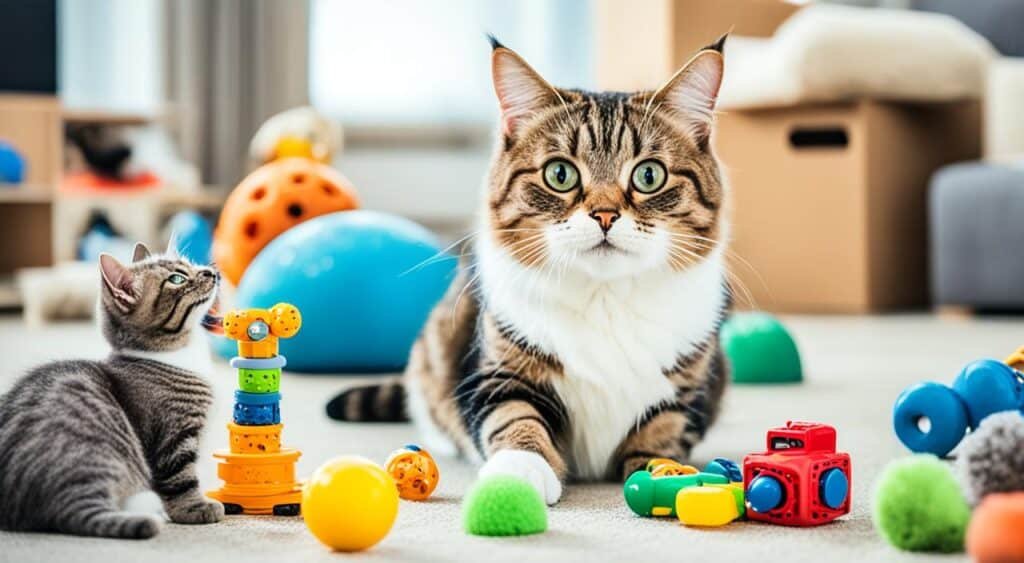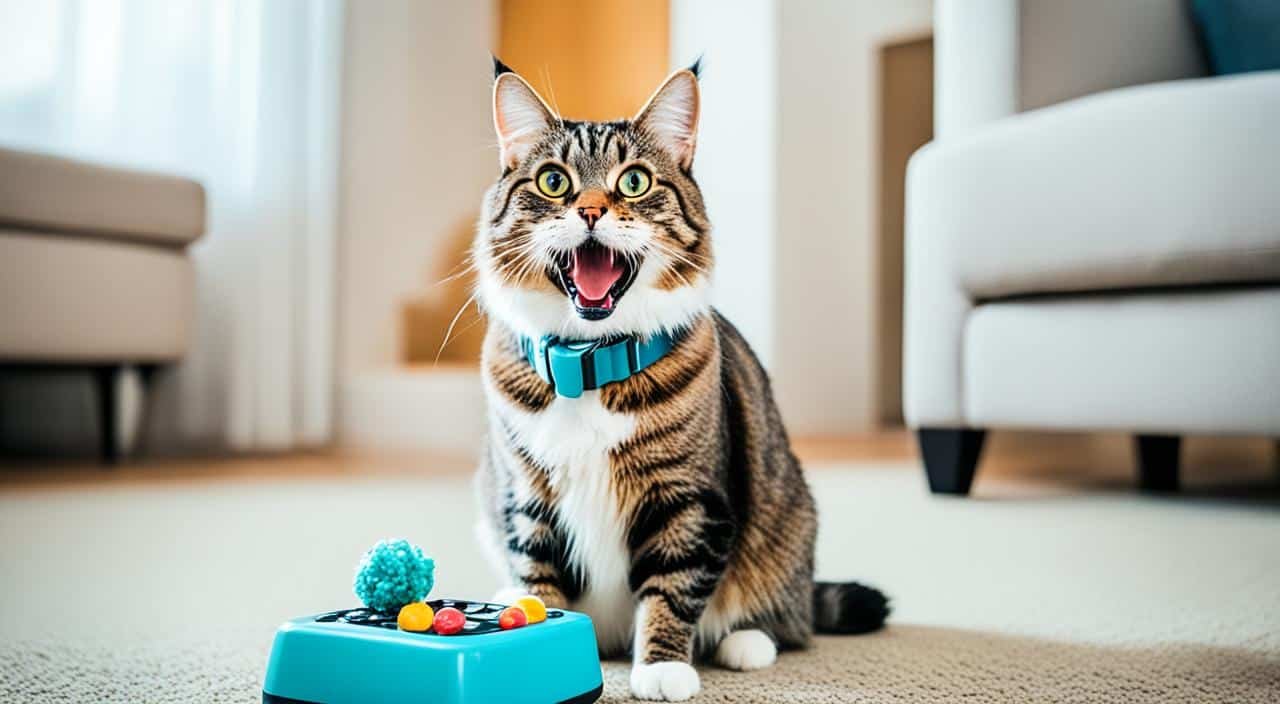Training your domesticated cat is not only fun but also strengthens your friendship. Use positive methods, and be patient and consistent. This helps the cat training be successful. You can teach your cat useful skills or fun tricks.
It’s vital to keep the training sessions upbeat and suited to your feline‘s likes. This way, your cat stays interested and learns quickly.
Key Takeaways:
- Positive reinforcement is the most effective training method for cats.
- Training can help build a stronger bond between you and your pet.
- Cat training provides mental and physical stimulation, reducing the risk of boredom-related behavior problems.
- Start with simple commands and gradually increase the difficulty as your house cat masters each skill.
- Consistency, patience, and finding the right rewards are crucial for successful cat training.
Also Read : Mondor’s Disease: Symptoms, Causes & Treatment
The Importance of Training Domesticated Cats
Training your cat can help you two get along better. It makes you understand what your cat is saying and feeling. This makes you trust each other more.
Building a Stronger Bond
Training your cat means spending quality time together. You get to know its likes and dislikes. This makes you both feel closer and understand each other better.
Providing Mental and Physical Stimulation
Training keeps your cat’s mind and body active. This stops them from getting bored and causing trouble. It meets their need to learn and play, so they stay happy and behave well.
Also Read : Exploring Electrical Engineering Technology Careers
Addressing Behavior Issues
Training can also fix bad habits. Like, if they scratch the furniture, you can teach them not to. This makes your home peaceful and keeps you and your cat happy.
Getting Started with Cat Training

Before kicking off your cat’s training, gather a few key tools and set some goals. You’ll need basic supplies like a clicker, target stick, and tasty cat treats. Don’t forget about extras like small cups, yoga blocks, a treat pouch, and a mat.
Also Read : Pursue Success With An Information Technology Degree
Gathering the Necessary Tools
Essential cat training tools are a clicker, a target stick, and top-notch treats. A clicker helps your cat understand when they’ve done something right with its clear sound. A target stick directs your cat’s focus and encourages certain movements. High-value treats like cooked chicken or freeze-dried meat are great for encouraging your cat during training.
Deciding on Training Goals
Now that you’ve got your tools, think about what you want to teach your cat. Do you need to stop some bad habits, help them gain new skills, or just have fun with tricks? Knowing your goal will keep you on track. Begin with simple tasks and move on to harder ones as your cat gets more at ease and confident.
If you want to work on litter box behavior, make car rides less scary, or just want to bond through tricks, it’s key to set clear goals. This approach makes your training focused and effective.
Also Read : Become A Pro With A Hotel Management Degree
Understanding How Cats Learn

Cats learn through associative learning. This means they connect actions with outcomes. Knowing this helps cat owners train their cats better. It’s all about understanding how your cat’s mind works.
Associative Learning
When a cat does something good and gets a treat or praise, they remember. This makes them more likely to do that good thing again. It’s like teaching them the right way to behave. This is called positive reinforcement.
Also Read : Unlock Your Future With A Digital Marketing Degree
Positive Reinforcement
Positive reinforcement is key in training cats. Reward them for the good things they do. Use treats or praise to show them what you like. This helps them learn what they should do more.>
Avoiding Punishment
Avoid punishing your cat. Things like water sprays can harm your bond and stress them out. Focus on rewarding good actions. This creates a happy learning environment. It builds trust between you and your cat.
Tips for Successful Cat Training

Training your house cat involves some simple but important steps. Starting with basic commands is key. Keep the training brief, and use the right treats to keep your cat interested. This will make learning fun and effective for your pet.
Start with Easy Commands
It’s best to begin cat training with easy commands like “sit” or target training. These simple tasks set the stage for learning more advanced behaviors later. Target training, rewarding your cat for touching a stick with their nose, is an effective starting point.
Keep Training Sessions Short
Since cats have a short attention span, sessions should only last 5-15 minutes. This makes sure your cat stays focused and doesn’t get overwhelmed. Always finish with something positive and simple.
Eliminate Distractions
A quiet, distraction-free space is vital for successful training. Keep away from loud noises and other pets. This allows your cat to fully focus on what you’re teaching.
Reward Immediately and Consistently
After your cat does something right, reward them immediately. Use the same cue words and treats every time. This teaches them clearly which behaviors you are happy with.
Find the Right Rewards
Choosing the right reward is critical. Try different treats like wet food, freeze-dried, or kibble to see what your cat loves. Remember, the best reward for your cat is what they want most.
With these tips, training your cat will be rewarding for both of you. Remember, using patience, sticking to a routine, and focusing on positive rewards is the way to go. Happy training for a happy cat!
Training Methods and Techniques
There are many ways to train your cat. One favorite method is clicker training. This approach is both loved and successful.
Clicker Training
Clicker training is super for cats. You use a small device that makes a “click” sound. You click when your cat does what you want, then give them a treat. This shows your cat what action is good and they’ll do it more.
Hand Signals
Using hand signals is also helpful. Cats can learn moves by watching your hands. Just make sure you use the same signals every time. This makes learning clear for your cat.
Voice Cues
Verbal commands are also effective. You say a word or phrase as you show the action. Like with hand signals, pick a word and stick with it. Consistent talk helps cats learn well.
Domesticated Cat Training Commands
Train your cat with key commands like litter training, carrier training, “sit,” and “high five.” These basics tackle common issues and build a strong bond with your pet.
Litter Training
Litter training shows your cat the litter box is the spot to go, keeping your home fresh. Put the box in a quiet place, easy for your cat to find. Reward them for using it, and stay patient as they pick up this new habit.
Carrier Training
Teaching your cat about carriers makes vet trips and travel less stressful. Let them check out the carrier at their own pace. Make it a fun place with food and play. Give treats or praise when they go in, and do short practice trips.
Sit
“Sit” is a great beginner trick for your cat. Start by getting them to sit with a treat, then add the word “sit.” Reward them each time they sit when you say it. Keep doing this until they sit on cue without the treat.
High Five
The “high five” trick is a cute way to connect with your cat. Hold a treat above their paw and say “high five.” Praise them when they touch their paw to your hand. Make it a bit tougher as they get better at it.
Use cheer and snacks to guide your cat in learning. Be calm, use short lessons, and make things a bit harder once they get the hang of it. With practice, your cat will learn many cool tricks.
Addressing Unwanted Behaviors
Training your cat can help fix bad behaviors. Cats may do things like jump on counters, bite, scratch furniture, chew inappropriately, eat plants, or yowl for food. The trick is to show them what they should do through positive actions.
Staying Off Countertops
To stop your cat from jumping on counters, give them high spots of their own, like cat trees or window perches. Reward them when they use these spots. Also, stop them from getting on counters and change their focus if they try.
Biting or Kicking
If your cat bites or kicks, teach them to be gentle. Reward them when they do this. Don’t punish them for bad actions. Instead, guide them to better activities.
Scratching Furniture
For scratching, give your cat a scratching post. Reward them for using it. You can also use a scratching deterrent on furniture. It will show them where to scratch and where not to.
Destructive Chewing
To halt destructive chewing, give your cat chew toys. Add fun with food puzzles. When they chew on wrong things, quickly show them the right items to chew on.
Eating Houseplants
Stop your cat from eating your plants by making them inaccessible or using deterrents. Offer cat-friendly plants to chew on instead. This can satisfy their plant-chewing urge.
Yowling for Food
If your cat meows a lot for food, stick to a feeding schedule without giving in to their calls. Praise and treat them when they’re quiet at meal times. Over time, they’ll learn to wait for their food.
Dealing with cat issues needs you to be consistent and patient. Use positive methods to teach different, better actions. This way, you can solve many behavior problems and keep your home calm and happy.
Also Read :Exploring The Diverse Animals In India
The Benefits of Training Your Domesticated Cat
Training your cat can greatly improve its actions. It teaches them good habits and reduces bad ones. This fun activity also keeps them from being bored, which can lead to trouble.
Improved Behavior
With training, your cat can learn what’s acceptable. They’ll know not to scratch the furniture or eat your plants. By praising good behavior, you can make your home more peaceful.
Mental Stimulation
Learning new things is a good challenge for cats. It keeps their minds sharp and makes them less likely to act out because of boredom. Training them is like exercise for the brain.
Physical Exercise
Training activities keep your cat moving. This includes jumping or walking on a leash. It’s a fun way for them to stay in shape, which is good for their health.
Stronger Bond
Training your cat actually makes your relationship stronger. You both learn to trust and understand each other better. This leads to a deeper connection, making both of you happier.
Training your cat means a healthier, smarter pet. It improves their behavior, keeps their mind and body fit, and brings you two closer. It’s a great way to enjoy life with your furry friend.
Conclusion
Training your cat is key to being a good pet owner. It’s essential for them to learn skills, change bad habits, and stay mentally and physically active. Doing this will make your cat happier and strengthen your friendship. And, with the right guidance, training can be fun for both of you.
At first, teach simple commands and keep lessons short. Always reward your cat for doing well. By making training a regular part of their day, you’ll see life-changing benefits. Your cat will behave better, be more engaged, and you’ll feel closer than ever.
Taking the time to train your cat means a better life for both of you. Celebrate every small win, and you’ll find joy in building a remarkable relationship. So, get started and enjoy this journey with your furry pal.





